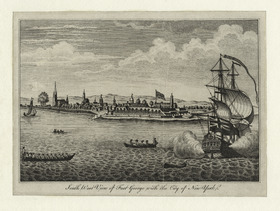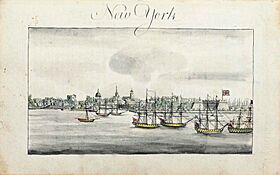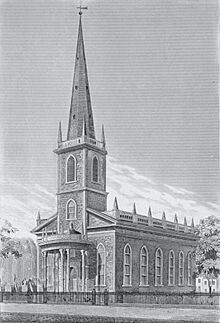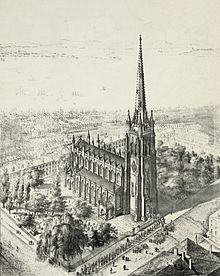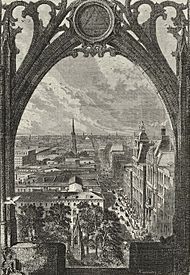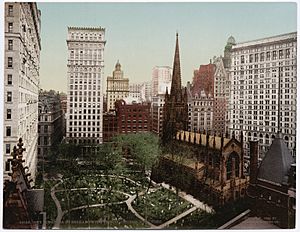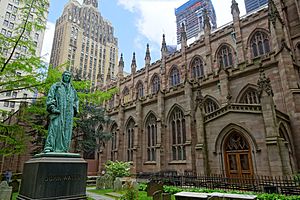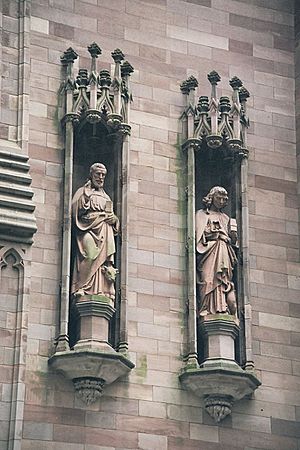Trinity Church (Manhattan) facts for kids
Quick facts for kids Trinity Church |
|
|---|---|
| Trinity Church, Wall Street | |
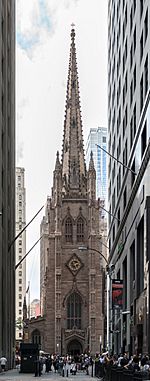
Seen from Wall Street
|
|
| 40°42′29″N 74°00′44″W / 40.70806°N 74.01222°W | |
| Location | 89 Broadway, Manhattan, New York |
| Country | United States |
| Denomination | Episcopal Church |
| Churchmanship | High Church |
| History | |
| Status | Parish church |
| Founded | May 6, 1697 |
| Founder(s) | William III of England |
| Dedicated | May 1, 1846 |
| Architecture | |
| Functional status | Active |
| Architect(s) | Richard Upjohn (church) Frederick Clarke Withers (renovations, altar, and rear addition) |
| Style | Gothic Revival |
| Years built | 1839–1846 1876–1877 |
| Groundbreaking | June 3, 1841 |
| Completed | 1846 |
| Specifications | |
| Capacity | 652 |
| Spire height | 281 feet (86 m) |
| Bells | 23 |
| Administration | |
| Deanery | Manhattan Lower |
| Diocese | New York |
| Province | Atlantic |
Trinity Church is a very old church in New York City. It is part of the Episcopal Church, which is a Christian group. The church building is located at 89 Broadway, right across from Wall Street in Lower Manhattan.
Trinity Church is famous for its long history, its important location, and its beautiful Gothic Revival style. The church community is known for following the traditions of the Episcopal Church. They focus on helping others and building community.
Besides its main church, Trinity also has two smaller chapels. These are St. Paul's Chapel in Lower Manhattan and the Chapel of St. Cornelius the Centurion on Governors Island. Many other churches in Manhattan used to be part of Trinity parish. Columbia University was even started on the church's land in 1754.
The building you see today is the third church built for this community. It was designed by Richard Upjohn. The first church was built in 1698 but was destroyed by a big fire in 1776. The second church was built in 1790. The current church was built between 1839 and 1846. For many years, it was the tallest building in the United States.
Trinity Church is next to the Trinity Churchyard, which is a burial ground. The church also owns many properties in New York City. The main church building is a National Historic Landmark and a New York City designated landmark.
Contents
History of Trinity Church
In 1696, Governor Benjamin Fletcher allowed the Church of England community to buy land in Lower Manhattan. They wanted to build a new church. King William III officially gave the church its charter on May 6, 1697. The first leader of the church was William Vesey. He served for 49 years.
The First Trinity Church Building

The first Trinity Church was a simple building with a special roof called a gambrel roof. It was built in 1698 on Wall Street, facing the Hudson River. Before the church, this land was a garden and then a burial ground. People from the Church of England wanted a church in New York City. It is said that Captain William Kidd helped build it by lending ropes and tools from his ship.
In 1705, Queen Anne of England gave the church more land. In 1709, Trinity School was started by William Huddleston. Classes were first held in the church's steeple. Later, in 1754, King George II of Great Britain started King's College (now Columbia University) near the church.
During the American Revolutionary War, New York City became a British base. Church leaders had to support the British. However, some church members were also American patriots.
The first church was destroyed in the Great New York City Fire of 1776. This fire burned down hundreds of buildings and left many people without homes. After the war, in 1784, Samuel Provoost became the new leader of Trinity Church. The New York State Legislature removed the part of the church's charter that said it had to be loyal to the King of England.
In 1789, after he became president, George Washington attended a special service at St. Paul's Chapel. This chapel is part of Trinity Church. St. Paul's Chapel is still used today and is the oldest public building in New York City that has been used continuously.
The Second Trinity Church Building
Building the second Trinity Church started in 1788. It was officially opened in 1790. St. Paul's Chapel was used for services while the new church was being built.
The second Trinity Church was much bigger than the first. It was 200 feet tall and faced Wall Street. A larger church was needed because New York City's population was growing. This church was taken down after heavy snows in the winter of 1838–39 damaged it.
The second Trinity Church was important because President Washington and other government leaders often went there. Famous people like John Jay and Alexander Hamilton were also members.
The Third Trinity Church Building
The third and current Trinity Church began being built in 1839 and was finished in 1846. When it was completed, its tall Gothic Revival spire, topped with a golden cross, was the tallest point in lower Manhattan. It was a welcoming sight for ships coming into New York Harbor.
In 1843, the Trinity Church community grew so much that it was divided. A new church, Grace Church, was built further north on Broadway. Both Grace and Trinity Churches were finished and opened in 1846.
Trinity Church was the tallest building in the United States until 1869. It remained the tallest building in New York City, with its 281-foot spire and cross, until 1890.
In 1876–1877, a special screen behind the altar, called a reredos, and a new altar were added. These were built in memory of William Backhouse Astor Sr.. The church also added a small extension at the back for clergy and choir rooms. The altarpiece was repaired during the church's renovation in the 2000s.
On July 10, 1976, Queen Elizabeth II and Prince Philip, Duke of Edinburgh, visited Trinity Church. The church leaders gave the Queen a symbolic "back rent" of 279 peppercorns. This was a fun way to remember the old land grant.
Trinity Church in the 21st Century
After the September 11 attacks in 2001, Trinity Church helped a lot. They used St. Paul's Chapel to offer help to first responders and volunteers at Ground Zero. They provided meals, medical care, and a place to rest. Many memorial items were left at St. Paul's Chapel to remember those who died. Some of these items are now at the National September 11 Memorial & Museum.
A large sycamore tree in St. Paul's churchyard was knocked over by falling debris from the attacks. A sculptor named Steve Tobin used its roots to create a bronze sculpture called Trinity Root. This sculpture stood in front of Trinity Church until 2015.
Trinity Church is also near Zuccotti Park, where the Occupy Wall Street protests happened. The church offered support to the protesters. However, they did not allow the protesters to set up camp on church-owned land called LentSpace.
Church Architecture
The third Trinity Church building, built in 1846, was designed by architect Richard Upjohn. It is a great example of the Gothic Revival style. In 1976, the United States government named Trinity Church a National Historic Landmark. This was because of its important architecture and its place in New York City's history.
In 2018, the church started a big renovation project. The goal was to make the building easier to use and more comfortable for people. They also wanted to restore old parts like the stained glass windows and interior walls. This renovation was finished in 2022. It made the church look like its original design and added modern features for services and concerts.
Church Bells
The tower of Trinity Church has 23 bells. The heaviest bell weighs about 2,700 pounds.
Eight of these bells were made for the second church building. Three more bells were added later. In 1946, these bells were changed to be rung by electric motors.
In 2006, 12 new bells were added. These bells are special because they are the first set of 12 "change-ringing" bells in a church in the United States. "Change ringing" is a special way of ringing bells in a pattern. The new bells were made in England.
Sometimes, the sound of the bells was very loud for people living nearby. So, the church added a wooden deck and shutters inside the bell tower. When these are closed, the sound outside is much quieter. The shutters are opened for public ringing.
You can hear the bells before and after the 11:15 a.m. Sunday service. They also ring on special days, like 9/11 events, weddings, and parades.
Church Doors
Trinity Church has three beautiful bronze doors. These were given by William Waldorf Astor, 1st Viscount Astor to honor his father. The doors were made in 1893 by different artists.
The north and east doors each have six panels that show scenes from church history or the Bible. The south door shows six panels about the history of New York City.
Church Art
In 2015, a priest at Trinity Church asked an artist to create a special artwork called Our Lady of Ferguson. In 2022, the church added a new stained-glass window above the main entrance on Broadway. This window, made by a British artist, shows stories from the Bible.
Burial Grounds
Trinity Church has three burial grounds:
- Trinity Churchyard: This is around the church itself. Many famous people are buried here, including Alexander Hamilton, Elizabeth Schuyler Hamilton, Robert Fulton, and Hercules Mulligan.
- Trinity Church Cemetery and Mausoleum: This is located on Riverside Drive. People like John James Audubon, John Jacob Astor, and Ed Koch are buried here. It is the only active cemetery left in Manhattan.
- The Churchyard of St. Paul's Chapel: This has memorials to important historical figures.
Church Services
Trinity Church offers many services throughout the week. These services follow the traditions of the Episcopal Church. They include daily prayers and Holy Eucharist (Communion). The church also hosts special events like weddings and baptisms.
Here is a typical schedule for services:
- Sunday:
- 8:00 a.m.: Trinity Church, Low Eucharist
- 9:00 a.m.: Trinity Church, Family Eucharist (also online)
- 11:15 a.m.: Trinity Church, Holy Eucharist (also online)
- 8:00 p.m.: Trinity Church, Compline by Candlelight
- Monday–Friday:
- 8:15 a.m.: Morning Prayer (online)
- 9:00 a.m.: Morning Prayer (in person)
- 12:05 p.m.: Holy Eucharist (also online)
- 5:15 p.m.: Evening Prayer (online)
- Wednesday:
- 5:30 p.m.: Contemplative Eucharist
Since 1993, Trinity Church has hosted the graduation ceremonies for the High School of Economics and Finance. This school is located very close to the church.
Leaders of Trinity Church
| Rector | Image | Start date | End date |
|---|---|---|---|
| William Vesey | 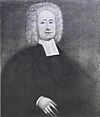 |
1697 | 1746 |
| Henry Barclay | 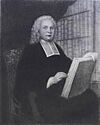 |
1746 | 1764 |
| Samuel Auchmuty | 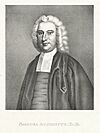 |
1764 | 1777 |
| Charles Inglis | 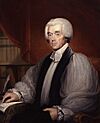 |
1777 | 1783 |
| Samuel Provoost |  |
1784 | 1800 |
| Benjamin Moore |  |
1800 | 1816 |
| John Henry Hobart | 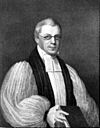 |
1816 | 1830 |
| William Berrian |  |
1830 | 1862 |
| Morgan Dix |  |
1862 | 1908 |
| William Thomas Manning | 1908 | 1921 | |
| Caleb Rochford Stetson | 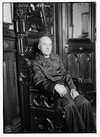 |
1921 | 1932 |
| Frederic Sydney Fleming | 1932 | 1951 | |
| John Heuss | 1952 | 1966 | |
| John Vernon Butler, Jr. | 1966 | 1972 | |
| Robert Parks | 1972 | 1987 | |
| Daniel Paul Matthews | 1987 | 2004 | |
| James H. Cooper | 2004 | 2015 | |
| William Lupfer | 2015 | 2020 | |
| Phillip A. Jackson | 2020 | present |
Music and Arts at Trinity
Trinity Church has a very active music program. They have been hosting "Concerts at One" since 1969, offering live classical and modern music. The church also has several choirs that perform on Sunday mornings. Trinity shares its music programs with the world through online video streaming.
The main music group is The Choir of Trinity Wall Street. This is a professional group that sings during church services. They also perform new music concerts, make recordings, and go on international tours. Sometimes, they are joined by the Trinity Baroque Orchestra, which plays old instruments, or NOVUS NY, which plays modern music.
Trinity also has a Youth Chorus, Youth Orchestra, Family Choir, and other arts programs. Visiting choirs from all over the world perform at Trinity every week.
Church Property and Holdings
Trinity Church is one of the largest landowners in New York City. It owns 14 acres of land in Manhattan, including many commercial buildings in Hudson Square. In 2019, the church's investments were worth over $6 billion. This makes it one of the richest churches in the world.
The church also owned many apartment buildings in New York City in the past. Today, it continues to manage its properties to support its mission and activities.
Images for kids
See also
 In Spanish: Iglesia de la Trinidad (Manhattan) para niños
In Spanish: Iglesia de la Trinidad (Manhattan) para niños


